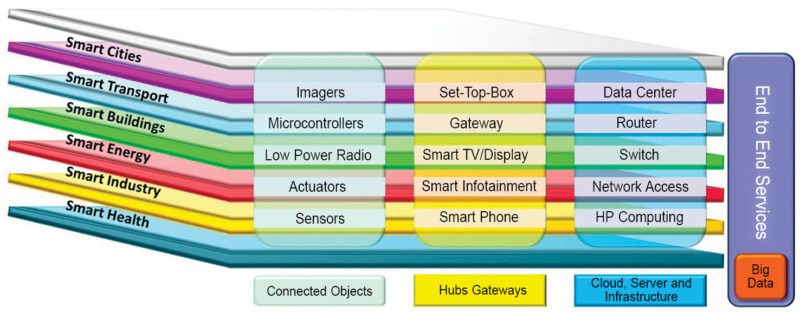With several billion devices expected to be connected to the Internet of Things (IoT) over the next few years, character of the mobile network will be changed completely. The types of devices involved broadly fall into two categories: massive machine-type communication (MTC) and mission-critical MTC. The demands these place on the network are very different from each other, as well as from those of traditional mobile terminals or user equipment. The resulting IoT ecosystem will be complex—multi-layered and cross-disciplinary as shown schematically in the figure.

Massive MTC
Protocols developed for mobile phones, smartphones and tablets are unnecessarily complex for high-volume non-speech devices that will be used for massive MTC, and these devices will also need to be low-power in order to have ultra-long battery life, and must have a low unit cost.
Massive MTC use cases include connected lifestyles and healthcare applications such as wearable technology, as well as smartenergy, public infrastructure and industrial automation. These applications generally have intermittent, low data rate requirements and no particular latency constraints, so will not need the high data rates promised for 5G.
Nevertheless, the sheer volume of devices forecast to connect to the IoT means that eventually the capacity of 5G will be needed to support these all. In the meantime, new low-complexity protocols are being introduced for 4G, which will allow significant numbers of MTC devices to work on 4G LTE networks up to and beyond the launch of 5G.
3GPP LTE-M standard (also known as Cat-M or Cat-M1) will enable lower-cost, lower-power M2M devices to work within the currently available mobile networks, and will also offer modes that improve in-building coverage.
Two further IoT standards, enhanced coverage GSM (EC-GSM) and narrow-band IoT (NB-IoT), are also being introduced. EC-GSM, as its name suggests, uses legacy 2G technology, while NB-IoT can be used with either 4G LTE or for re-farming of GSM channels.
NB-IoT is a new narrow-band radio technology introduced by 3GPP to specifically address the requirements of the IoT. Standardisation began in September 2015 and is still ongoing. It is designed to improve indoor coverage as well as provide support for a massive number of low-cost, low-throughput devices with low device power consumption and optimised network architecture.
NB-IoT can either be deployed in-band, utilising resource blocks within a normal LTE carrier or its guard band, or in a standalone mode for deployments in non-LTE spectrum. It will entail a radical change to the physical layer, occupying a bandwidth of only 200kHz including guard-bands. This allows one GSM/GPRS channel to be directly replaced by one NB-IoT channel, or many more to be accommodated within an LTE channel where it can share capacity and mobile-site resources with regular LTE data traffic, thus enabling LTE networks to accommodate many more MTC devices.
Mission-critical MTC
At the opposite end of the scale, mission-critical MTC applications include driverless vehicles and robot surgery, and will have stringent requirements on both reliability and low latency. These form one of the key use cases for 5G, and new network strategies including mobile edge computing (MEC) are being developed to cater to these.
The accelerating development of 5G is partly being driven by a demand for expanding the networks to enable the secritical IoT use cases, where the need for low-latency and high-reliability devices cannot be met using existing connectivity technologies.
Looking to the future, 4G, 5G and legacy mobile will all form part of the eventual IoT mix. Many IoT devices need to operate indoors, so issues of in-building penetration need to be addressed as well. New architectures and frequency bands may be needed to improve indoor coverage. A mixture of heterogeneous networks (HetNets) using small cells, Wi-Fi offload and more innovative indoor coverage solutions such as intelligent digital DAS (idDAS), which allows mobile operators to use flexible repeater solutions to dynamically allocate capacity within buildings or areas is expected to form part of the solution.
Software-defined networks utilising network function virtualisation and self-optimising networks will increasingly be used by operators to help make networks more flexible and responsive to changes in demand. These will form an integral part of the development of the IoT, and in managing network resources to cope with the extra traffic that it will generate.
Network test and validation
These large volumes and diversity of devices and applications will introduce a new set of challenges in testing and validation, not only for the devices themselves but also for the networks that will support these. Mobile networks that are being expanded to include the IoT will also need new kinds of testing, and the effect of loading the network with millions of these devices will need to be validated.
Although individual devices may not need much bandwidth, with millions more devices coming online, efficiencies of 4G and 5G will be required, in order to increase the overall capacity of the network to be able to handle these.
Availability of network validation tools that emulate realistic data usage scenarios has been vital to the development and rollout of LTE, and in the future it will be equally important to include the characteristics of the predicted volume of IoT devices in the traffic models, in order to ensure quality of service and quality of user experience as 5G networks develop.
The philosophy of testing by design will provide the wireless industry with the blueprint to begin developing this framework, and this will necessitate the use of a validation environment based on virtualised network functions that can apply realistic scenarios for all types of users—consumers, businesses and things.
Latest generation of TM500 network test system already has the capability to emulate certain types of M2M/MTC devices, to evaluate the effect on the network of connecting large numbers of these low-power, low-complexity devices. This helps network operators and infrastructure vendors to validate 4G mobile network performance in preparation for deploying IoT connectivity.
Phil Medd is senior technical product manager, Cobham Wireless








